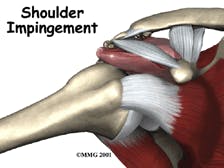By: Dr. Brian P. Kinmartin, PT, DPT, MTC, OCS, STC, CWcHP, Cert. DN

In the aging population shoulder pain is a common occurrence. Bursitis is the most common dysfunction of the shoulder in the aging population and often leads to shoulder impingement syndrome, which may eventually lead to rotator cuff pathology or tear. The main goal of this editorial is to briefly describe these causes of shoulder pain and the way in which orthopaedic-based physical therapy can assist in resolving shoulder pain.
The shoulder joint is a ball and socket joint with the end of the arm bone or humerus creating the ball component. The shoulder blade or scapula creates the socket. The acromion is the front edge of the shoulder blade and it sits over and in front of the head of the humerus. The rotator cuff is a group of four muscles that work together to stabilize the ball in the socket, as well as lift and rotate the arm. These muscles attach to the ball component of the shoulder. There is a small space underneath the acromion and the top of the humerus in which the rotator cuff travels through. Normally, when you raise your arm these tendons slide smoothly within this space. In some people this space becomes too narrow, and the tendons and bursa located within this space become inflamed. The bursa is a small fluid filled sac that helps provide a cushion between bones and tendon. Inflammation leads to thickening of the tendons and bursa, which further decreases this space. Eventually this space becomes too narrow to accommodate the tendons and the bursa, and as the arm is lifted the acromion rubs, or "impinges" on, the surface of the rotator cuff. This causes pain and limits movement.
With impingement syndrome there may be age related degenerative changes of the shoulder or there may be an injury that sets off the process of inflammation. Once there is an injury, the tendons and bursa become inflamed, which leads to thickening of these structures. The thickening then takes up more space, which causes pinching of the rotator cuff. This continues to cause more thickening, which continues to worsen the problem. Eventually this pinching may lead to disruption of the rotator cuff tendon, which is more commonly known as a rotator cuff tear. Some of the most common symptoms of shoulder impingement syndrome are; pain or tenderness over the outside region of the shoulder, pain with overhead activities or reaching behind the back, and pain while sleeping at night, especially when lying on affected shoulder.
Physical Therapists by training are experts in human anatomy and mechanics. They are trained in disease processes and how abnormal motions, positions, and activities can contribute to or cause painful syndromes. Once the cause of a syndrome is identified the use of modalities, therapeutic exercise or activities are used for the correction of abnormal mechanics, postures or positions. Orthopaedic physical therapy for the treatment of impingement syndrome can help upfront to manage the causes of inflammation inside of the shoulder inhibiting the impingement cascade. By managing your posture, reducing inflammation in the shoulder and strengthening your rotator cuff with instruction in prevention and wellness by a qualified Physical Therapist, in many instances shoulder impingement syndrome is a very manageable condition. Physical Therapy is a referred service managed by your current Medical Practitioner. Once a diagnosis of Shoulder Impingement Syndrome is made if appropriate they will direct you towards our service. Like many Physicians some Physical Therapists have chosen to specialize in Orthopaedics and may be more knowledgeable in this area.
Dr. Brian P. Kinmartin, PT, DPT, MTC, OCS, STC, CWcHP, Cert. DN and Richard A. Owens, PT, MS, OCS, Cert. SHT, CWcHP, Cert DN who work at Professional Rehabilitation Services in Pawleys Island, SC and Dr. Richard DeFalco, DPT, OCS, CSCS, CWcHP, Cert. DN who works at Professional Rehabilitation Services in Myrtle Beach are Board Certified Orthopaedic Specialists through the American Physical Therapy Association. For more information on this topic please contact Dr. Brian P. Kinmartin, PT, DPT, MTC, OCS, STC, CWcHP, Cert. DN at Professional Rehabilitation Services.
